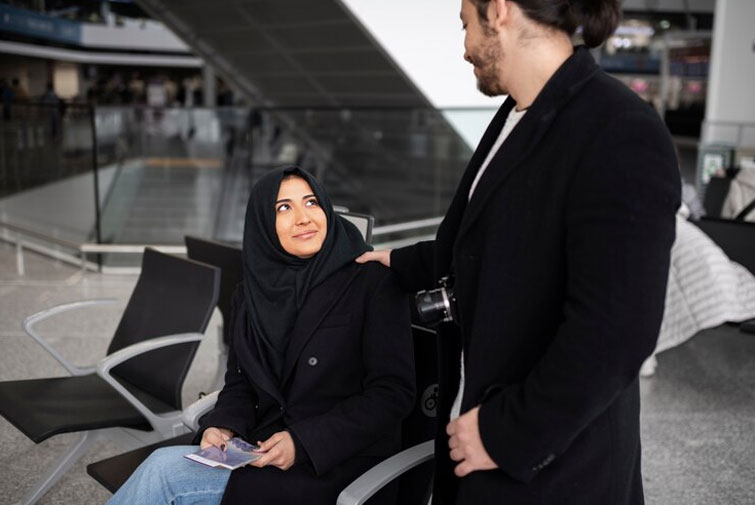Tasbeeh For Love – How To Perform Salatul Tasbeeh
Admin-haider
- May 21, 2021
- 17 min read
- 591 Views

Tasbeeh For Love – How To Perform Salatul Tasbeeh
In the tapestry of Islamic practices, Tasbeeh, or the act of praising and remembering Allah, holds profound significance. As believers, we embark on a spiritual journey that transcends mere rituals, seeking a deeper connection with our Creator. At the heart of this journey lies the enchanting practice of Salatul Tasbeeh – a prayer intricately woven with threads of love and devotion.
Salatul Tasbeeh, a distinctive form of prayer, unveils itself as a pathway to not only fulfill our religious duties but also to nurture and amplify the love that resides within our hearts. In this exploration, we delve into the multifaceted layers of Tasbeeh and its intertwining with the essence of love.
Understanding Tasbeeh
In the realm of Islamic devotion, Tasbeeh emerges as a luminous jewel, shimmering with divine significance. Defined as the repetitive glorification of Allah, Tasbeeh serves a dual purpose – it strengthens our connection with the Divine and acts as a beacon in our daily prayers.
The purpose of Tasbeeh in Islam extends beyond a mere recitation; it is a gateway to mindfulness and spiritual reflection. As we incorporate Tasbeeh into our daily prayers, we find ourselves immersed in a sea of divine remembrance, guided by the wisdom of Quranic verses that echo the importance of acknowledging Allah in every facet of our lives.
Quranic references resound with the call for believers to engage in the constant remembrance of Allah. Through Tasbeeh, we heed this divine call, recognizing that in every prayer lies an opportunity to strengthen our bond with the Almighty. The Quran illuminates the path of remembrance, encouraging us to weave the threads of Tasbeeh into the fabric of our daily existence, reinforcing our commitment to a life centered on faith and love.
The Concept of Love in Islam
In the rich tapestry of Islam, love unfolds as a multifaceted gem, reflecting the divine light of Allah’s mercy. Islam teaches that love encompasses various forms – from the profound love for Allah to the compassionate love for fellow beings. Quranic verses and Hadiths intricately weave the importance of love into the fabric of Islamic teachings, reminding us that love is not only an emotion but a guiding principle for righteous living. The practice of Tasbeeh serves as a conduit for nurturing love, bridging the gap between the worshipper and the Beloved, fostering a deep and transformative connection.
Salatul Tasbeeh: A Special Form of Prayer
Salatul Tasbeeh, a unique and spiritually enriching prayer, stands as a testament to the depth of Islamic devotion. This special form of prayer is not merely a set of ritualistic movements but a sacred journey that intertwines the believer’s soul with the historical significance of its origins. Delving into the historical background and unraveling its significance, Salatul Tasbeeh emerges as a powerful vehicle for unlocking the gates of divine love. The benefits of this prayer extend beyond the spiritual realm, reaching into the very core of one’s being, fostering a profound and lasting love for Allah and His creation.
Step-by-Step Guide on How To Perform Salatul Tasbeeh
1. Niyyah (Intention)
The foundation of any prayer lies in a sincere intention. Before embarking on Salatul Tasbeeh, it is crucial to set a genuine intention, aligning your heart with the purpose of seeking Allah’s pleasure and love through this sacred act.
2. Takbir (Allahu Akbar)
Initiate the prayer with the Takbir, acknowledging the greatness of Allah. This powerful declaration sets the tone for a connection between the worshipper and the Divine.
3. Recitation of Surah Al-Fatiha and Other Verses
Incorporate the recitation of Surah Al-Fatiha and specific verses, immersing yourself in the divine words that guide and illuminate the path of Tasbeeh.
4. Performing the Tasbeeh
Step into the rhythm of Tasbeeh, engaging in the repetitive glorification of Allah. Let each bead of the Tasbeeh serve as a step towards a deeper connection and love.
5. Rukoo’ (Bowing) and Sujood (Prostration)
Integrate the Tasbeeh into the bowing and prostration, allowing the physical movements to synchronize with the spiritual surrender, deepening the love and submission to Allah.
6. Tashahhud and Tasleem
Complete the prayer with the final Tashahhud and Tasleem, sealing the sacred communion with a gesture of peace. This signifies the culmination of a prayer woven with love and devotion.
Importance of Consistency
Consistency forms the backbone of spiritual growth. Emphasizing the regular practice of Salatul Tasbeeh, we encourage believers to weave this prayer into the fabric of their daily routines. By making it a consistent part of life, the benefits extend beyond the immediate, creating a lasting impact on the heart and soul. In the embrace of consistent Tasbeeh, the love for Allah flourishes, leading to a life of profound fulfillment and spiritual contentment.
Personal Experiences and Testimonials
Case Study: Amina and Sameer – Rediscovering Love through Salatul Tasbeeh
Amina and Sameer, a couple residing in Mumbai, found themselves at a crossroads in their marriage. The demands of daily life had cast a shadow over their once vibrant connection, leaving them yearning for the warmth that had initially brought them together. Seeking guidance, they turned to the transformative practice of Salatul Tasbeeh.
Background: Amina and Sameer had been married for eight years, navigating the challenges of career demands, family responsibilities, and societal expectations. The initial spark had dimmed, and communication had become strained. In their quest for a solution, they approached Molvi Hazarat Haider Ali, a renowned Islamic scholar.
Astrological Interventions: Molvi Hazarat Haider Ali recommended incorporating Salatul Tasbeeh into their daily routine, emphasizing its power to rekindle love and strengthen the bond between spouses. Amina and Sameer, willing to try anything to salvage their relationship, embraced this spiritual practice.
Results: The impact of Salatul Tasbeeh on Amina and Sameer was profound. As they engaged in the prayer together, the repetitive glorification of Allah became a shared journey, fostering a renewed sense of unity. The bowing and prostration became moments of vulnerability, allowing them to express their innermost feelings to the Divine and each other.
Over time, the consistency of Salatul Tasbeeh became a cornerstone of their relationship. Amina and Sameer found themselves communicating more openly, understanding each other’s needs, and appreciating the essence of love within their union. The spiritual depth brought about by Salatul Tasbeeh not only revitalized their marriage but also strengthened their individual connections with Allah.
In their testimonial, Amina shared, “Salatul Tasbeeh became a sacred space for us. It’s not just a prayer; it’s a conversation with Allah that healed our hearts and, in turn, our marriage. We are grateful to Molvi Hazarat Haider Ali for guiding us toward this transformative journey.”
Testimonial: Rahim’s Journey to Self-Discovery Through Salatul Tasbeeh
Rahim, a young professional from Delhi, found himself grappling with inner turmoil and a sense of emptiness. Despite his material success, he felt disconnected from his purpose and longed for a deeper connection with Allah. In his pursuit of spiritual fulfillment, he discovered the profound impact of Salatul Tasbeeh.
Background: Rahim, in his late twenties, faced the typical challenges of modern urban life—long work hours, societal expectations, and the quest for personal success. However, the void within him persisted, leading him to explore avenues beyond the material world.
Astrological Interventions: Rahim sought guidance from Molvi Hazarat Haider Ali, who recommended the practice of Salatul Tasbeeh as a means of self-discovery and spiritual fulfillment. Embracing this suggestion, Rahim incorporated the prayer into his daily routine, seeking solace and purpose.
Conclusion
In the tapestry of spiritual practices, the threads of Tasbeeh and Salatul Tasbeeh weave a profound connection between the worshipper and the Divine. Through this exploration, we’ve uncovered the significance of Tasbeeh in Islamic practice, delved into the transformative nature of Salatul Tasbeeh, and witnessed its unique ability to nurture and strengthen the love that resides within our hearts.
Key Points:
- Tasbeeh’s Significance: Tasbeeh is not merely a ritual; it’s a pathway to mindfulness, a continuous remembrance of Allah that elevates our spiritual journey.
- Salatul Tasbeeh’s Transformative Power: This special form of prayer goes beyond the physical movements—it becomes a sacred dialogue, fostering a deep connection and love for Allah and others.
- Love’s Connection: Love, as taught in Islam, takes various forms, and the practice of Tasbeeh becomes a conduit for nurturing and amplifying this divine emotion.
Encouragement: As we conclude, let’s embrace the wisdom encapsulated in Salatul Tasbeeh. Let it not be just a prayer but a journey—a journey towards a more fulfilling and spiritually enriched life.
Contact us
Share Your Journey: We invite you, our cherished readers, to share your experiences with Salatul Tasbeeh. How has this prayer impacted your life and relationships? Your stories can inspire and guide others on their spiritual journeys.
Questions and Comments: Have questions or reflections to share? We welcome your comments! Let’s engage in a dialogue that fosters understanding and growth.
Seek Guidance: For those seeking further guidance on incorporating Salatul Tasbeeh into your spiritual practices, Molvi Hazarat Haider Ali is here to assist you. Feel free to reach out for personalized advice and support.
Contact Molvi Hazarat Haider Ali:
- Website: www.loveistikharawazifa.com
- Contact: +919588082026
May your journey with Salatul Tasbeeh be one filled with love, enlightenment, and spiritual fulfillment. Let the echoes of Tasbeeh reverberate in your heart, guiding you towards a more profound connection with Allah and a life enriched with love.
Results: Salatul Tasbeeh became a transformative journey for Rahim. The prayer served as a compass, guiding him through moments of reflection and gratitude. The repetitive glorification of Allah became a source of inner peace, and the physical movements of the prayer provided a sense of discipline and mindfulness.
Through Salatul Tasbeeh, Rahim discovered a renewed connection with Allah, unlocking a sense of purpose and contentment that had eluded him. The prayer became a sanctuary for self-reflection, allowing him to navigate life’s challenges with a newfound resilience.
In his heartfelt testimonial, Rahim expressed, “Salatul Tasbeeh brought me closer to Allah and, in doing so, brought me closer to myself. It’s a spiritual journey that has transformed my perspective on life, and I am grateful for the guidance of Molvi Hazarat Haider Ali.”
These real-life examples showcase the diverse ways in which Salatul Tasbeeh can have a positive impact on individuals, fostering love, connection, and spiritual growth.

Tasbeeh For Love – Unlocking the Power of Salatul Tasbeeh
Tasbeeh For Love
A Tasbeeh, a form of dhikr in Islam, involves the glorification of Allah SWT through the repetition of phrases like Subhanallah. While Tasbeeh is a general form of prayer, Tasbeeh for love serves a specific purpose – seeking love in life or rekindling lost love.
Marital relationships benefit from Tasbeeh for love between husband and wife. The Tasbeeh for husband love, recommended by our expert, addresses relationship challenges and offers a path to resolution.
Navigating the Delicate Bonds of Love
Relationships based on love are intricate and, despite their uniqueness, can pose challenges. When love becomes a source of problems, turning to the Tasbeeh for love becomes a valuable practice.
One-sided love, a painful experience for many, can be transformed through the Tasbeeh for love. This prayer holds the key to reciprocating love and turning one-sided affection into mutual connection.
Tasbeeh For Husband Love
For a married woman seeking her husband’s love and respect, the Tasbeeh for husband love is a powerful recourse. Follow these steps to perform the Tasbeeh for husband love:
- Begin by cleansing yourself thoroughly and performing wudu.
- Don fresh clothes after completing the ablution.
- Recite Durood Sharif eleven times.
- Chant the verse “Yaa Allaahu Yaa Fattahuu” 303 times.
- Conclude with eleven more recitations of Durood Sharif.
- Repeat this ritual until you sense a positive shift in your husband’s behavior.
Unlocking the Salatul Tasbeeh
Salatul Tasbeeh, a unique form of salah, is recommended by Prophet Muhammad, emphasizing its significance at least once in a believer’s life. Comprising 4 rakats, each with 75 tasbihs, it stands apart from regular salah.
Performing Salatul Tasbeeh:
- Begin each rak’at by declaring your intention.
- Recite all the tasbihs for each rakat.
- Complete a total of 300 tasbihs.
For a detailed understanding of how to perform Salatul Tasbeeh, reach out to our knowledgeable Maulvi Sahab. He will guide you through the process, ensuring clarity and adherence to this special form of salah.
Tasbeeh For Love – Illuminating the Path for Muslim Couples
Unlocking Spiritual Connections through Tasbeeh
Tasbeeh, a rhythmic expression of Allah’s praises, holds profound spiritual importance. Salatul Tasbeeh, a form of this practice, becomes a powerful means to invoke Allah’s grace, particularly in strengthening the love between spouses. Tasbeeh serves as a conduit not only to connect with Allah but also to deepen the bonds of affection with our loved ones.
Performing Salatul Tasbeeh: A Simple Guide
Salatul Tasbeeh is a unique prayer involving the recitation of specific phrases, seamlessly integrated into your daily routine. Here’s a step-by-step guide on how to perform Salatul Tasbeeh:
- Intention (Niyyah): Commence with a heartfelt intention to seek Allah’s blessings for the love between you and your spouse.
- Takbir: While standing, raise your hands and proclaim “Allahu Akbar” (Allah is the Greatest).
- Recitation: In each rak’ah, recite the Tasbeeh 15 times: “SubhanAllahi wal hamdulillahi wa la ilaha illallahu wallahu akbar.”
- Ruku’ and Sujood: Follow with the usual bowing and prostration.
- Completion: After four units, offer a final Tashahhud and Salam as in regular prayers.
Tasbeeh For Husband Love
A wife’s yearning for her husband’s love is natural, but sometimes efforts yield no results. Understanding the practice of Tasbeeh for husband’s love becomes essential. Here’s how a married woman can engage in this meaningful Tasbeeh:
- Personal Cleanliness: Ensure personal cleanliness through proper ablution (wudu).
- Attire: Put on fresh attire after completing ablution.
- Durood Sharif: Recite the Durood Sharif eleven times as a gesture of respect to Allah.
- Verse Recitation: Follow the Durood with the repetition of the verse “Yaa Allaahu Yaa Fattahuu” for a total of 333 times.
- Conclusion: Conclude with eleven more recitations of Durood Sharif.
- Persistence: Persist until a positive shift in the husband’s behavior becomes noticeable.
The Tasbeeh for husband’s love transcends ritual, evolving into a spiritual practice nurturing harmony and affection within the marital bond.
Tasbeeh for Love Between Husband and Wife
Love is the foundation of a thriving marriage, and tasbeeh for love between husband and wife can amplify this connection. Engaging in tasbeeh together fosters a shared spiritual experience, deepening emotional bonds. Here’s how to incorporate Tasbeeh into your relationship routine:
- Dedicated Time: Set aside a dedicated time each day to sit together and hold your tasbeeh beads.
- Repetitive Praise: Engage in the rhythmic praise of Allah.
- Silent Prayers: As you recite the tasbeeh, silently offer prayers for each other’s well-being, happiness, and a stronger bond of love.
Incorporating tasbeeh into your relationship routine brings tranquility, understanding, and compassion. It serves as a reminder of the sacred commitment shared as spouses, fostering gratitude for the blessing of each other.
Tasbeeh For Love Marriage
Express your affection with a thoughtful gesture for your partner in a love marriage:
- Create a Bouquet: Prepare a bouquet of your partner’s favorite flowers or their preferred dish.
- Recite a Loving Prayer: “Makaa naahh Muhh Amma Dunaa Bahh Adim miri Jaalik Umwal aa Kirraa Sulal ahiWa khataa Man nna Biye nWakaan Allahu Bikuli Sheyy In Alima”
- Symbolic Offering: Gently blow this prayer over the flowers or food, infusing it with the warmth of your emotions.
- Presentation: Present this thoughtful gesture to your beloved, a token of your affection and a symbol of the connection you share.
Embrace the profound impact of Tasbeeh for love, enriching the spiritual and emotional dimensions of your relationships.
Unlocking Spiritual Purification with Salatul Tasbeeh
Introduction to Salatul Tasbeeh
Salatul Tasbeeh, a profound act of worship, holds the promise of wiping away sins—past, present, hidden, open, intentional, and unintentional. This divine prayer, bestowed upon us by the Prophet Muhammad (saw), becomes a sanctifying ritual to cleanse our souls.
How to Perform Salatul Tasbeeh
The process involves a meticulous sequence of actions within four rakats, with each rakat consisting of 75 tasbihi. Follow these steps to perform Salatul Tasbeeh:
- Ablution (Wudu): Begin with the intention of praying four rakats.
- Recitation: In each rakat, recite Suratul Fatiha and another surah from the Holy Qur’an. Before proceeding to rukuu, recite:
- SubhanAllahi, Walhamdulillahi, Walailaha Illallahu Allahu Akbar (15 times).
- Rukuu (Bow): While in rukuu, recite the tasbihi 10 times.
- After Rukuu: Rise and recite the tasbihi 10 times before proceeding to sujud.
- Sujud (Prostration): In sujud, recite the tasbihi 10 times.
- After Sujud: After rising from sujud, sit and recite the tasbihi 10 times before the second sujud.
- Second Sujud: In the second sujud, recite the tasbihi 10 times.
- Conclusion: Sit and recite the tasbihi 10 times before standing up for the next rakat.
- Repeat: Repeat the process for the remaining three rakats.
By the end of the prayer, you would have recited a total of 300 tasbihi.
When to Perform Salatul Tasbeeh
The Prophet recommended performing Salatul Tasbeeh daily. However, if daily isn’t feasible, strive for every Friday. If that proves challenging, aim for monthly, and if that too is difficult, then at least yearly. Ultimately, even once in a lifetime holds immense value.
Benefits of Salatul Tasbeeh
The rewards of diligently performing Salatul Tasbeeh are boundless. Allah’s forgiveness extends to sins as vast as the sky or as abundant as water in a sea of hamadah. The promise of Janna awaits those who perform this sacred act with sincerity and devotion.
Conclusion
Embrace this divine bonus bestowed upon us. Let us not allow this opportunity to slip away. May Almighty Allah grant us the strength, time, and dedication to engage in this profound act of worship. May His blessings shower upon those who share this sacred knowledge, and may we all reap the rewards of spiritual purification.
Enhancing Spiritual Connection: Post-Salah Dua’s and Tasbih
After performing the Fard Salah, it is recommended to engage in supplications and Tasbih (Tasbeeh) as per the guidance from the Qur’an and Sunnah. This practice serves to deepen one’s connection with Allah, seeking blessings and expressing gratitude.
Post-Salah Supplications
Immediately after Salah, recite the following supplication:
“O Allah, You are the Peace, and You are the Source of Peace. Blessed are You, O Possessor of Glory and Honor.”
“Upon our Messenger be blessings.”
Tasbeeh (Tasbih) After Salah
Silently recite the following Tasbeehs:
- Subhanallah (Glory be to Allah): 33 times
- Alhamdulillah (Praise be to Allah): 33 times
- Allahu Akbar (Allah is the Greatest): 33 times
Additionally, recite:
“There is no god but Allah alone, He has no partners, to Him belongs dominion and to Him belongs praises, and He has power over all things.”
General Dua After Salah
Seek refuge in Allah from Satan and recite Bismillah before reciting Ayat al Kursi (The Throne Verse). Follow this with the general dua:
“I seek refuge in Allah from the accursed Satan. In the name of Allah, the Most Gracious, the Most Merciful.”
Recite the supplication our Prophet recommended:
“O Allah! I devote myself only to You by accepting Your enjoinders and prohibitions. I only rely upon You. I only believe in You. I turned my face and my heart only to You.”
Conclusion
Embrace these post-Salah practices to enhance your spiritual journey. Seek forgiveness, express gratitude, and seek Allah’s guidance in your daily life. The recommended supplications and Tasbeeh serve as a means to deepen your connection with the Divine and foster a sense of tranquility and gratitude.









